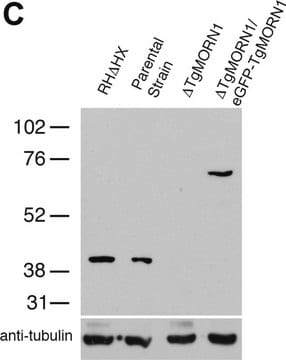T7451
Anti-Acetylated Tubulin antibody, Mouse monoclonal
clone 6-11B-1, purified from hybridoma cell culture
Synonym(s):
Acetylated Tubulin Antibody, Acetylated Tubulin Antibody - Monoclonal Anti-Acetylated Tubulin antibody produced in mouse, Anti Acetyl Tubulin antibody, Anti Acetyl-alpha tubulin
About This Item
Recommended Products
biological source
mouse
Quality Level
conjugate
unconjugated
antibody form
purified immunoglobulin
antibody product type
primary antibodies
clone
6-11B-1, monoclonal
form
buffered aqueous solution
species reactivity
bovine, frog, invertebrates, human, hamster, mouse, protista, pig, monkey, chicken, rat, plant
packaging
antibody small pack of 25 μL
concentration
~1 mg/mL
technique(s)
dot blot: suitable
electron microscopy: suitable
immunohistochemistry: suitable
radioimmunoassay: suitable
western blot: 0.03-0.06 μg/mL using total rat brain extract
isotype
IgG2b
UniProt accession no.
application(s)
research pathology
shipped in
dry ice
storage temp.
−20°C
target post-translational modification
acetylation (Lys40)
Gene Information
human ... TUBA4A(7277)
mouse ... Tuba1a(22142)
rat ... Tuba1a(64158)
General description
Specificity
Immunogen
Application
- quantitative dot blot
- immunofluorescence
- Western blot
- immunocytochemistry
- enzyme-linked immunosorbent assay (ELISA)
- solid-phase radioimmunoassay (RIA)
- electron microscopy
Biochem/physiol Actions
Physical form
Disclaimer
Not finding the right product?
Try our Product Selector Tool.
recommended
Storage Class Code
10 - Combustible liquids
WGK
WGK 3
Flash Point(F)
Not applicable
Flash Point(C)
Not applicable
Personal Protective Equipment
Certificates of Analysis (COA)
Search for Certificates of Analysis (COA) by entering the products Lot/Batch Number. Lot and Batch Numbers can be found on a product’s label following the words ‘Lot’ or ‘Batch’.
Already Own This Product?
Find documentation for the products that you have recently purchased in the Document Library.
Customers Also Viewed
Our team of scientists has experience in all areas of research including Life Science, Material Science, Chemical Synthesis, Chromatography, Analytical and many others.
Contact Technical Service












